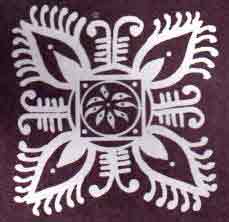 The designs of Alpana are always associated with beliefs that have come down through generations. The Alpana rangoli designs are generally round, with Hindus and Muslims using different paintings. Both, however, share the practice of painting the Alpana on their vessels.
The designs of Alpana are always associated with beliefs that have come down through generations. The Alpana rangoli designs are generally round, with Hindus and Muslims using different paintings. Both, however, share the practice of painting the Alpana on their vessels.
Detailed accounts of such Alpana rangoli painting can be held in Sanskrit literature. The Alpana Rangoli design paintings are of varied types and designs. The only picture a lady does not paint is of herself. After the Alpana rangoli design is complete the lady lights a lamp of ghee, clarified butter, then kneels down and touches her forehead to the ground in respect.
The Alpana rangoli often contain designs of the ornaments, the houses, trees, which are not really works of art but together form a chart of human desires. On the other hand, the different types of lotus, the various creepers, and the designs painted on wooden seats, these have come from the imagination and constitute decorative art.
Related: Alpana Designs Picture Gallery.
Alpana Painting of Shiva and Durga, their heavenly abode, followed by Lakshmi and Narayan are found. Other motif designs of Alpana are images of Rama, Lakshmana, and Sita, Kartick and Ganesh, the sea, the sun, the moon.
Muslims sometimes use turmeric past for alpana design at their weddings.



In South India, the Alpana designes are seen mostly in Tamil Nadu. In Tamil Nadu, the ninth day of the Durga Puja is celebrated as Saraswati Puja, and Alpana rangoli geometric patterns are painted. The first day of harvesting is celebrated as Pongal and the Alpana motifs include the lotus, butterfly, flowers and leaves.